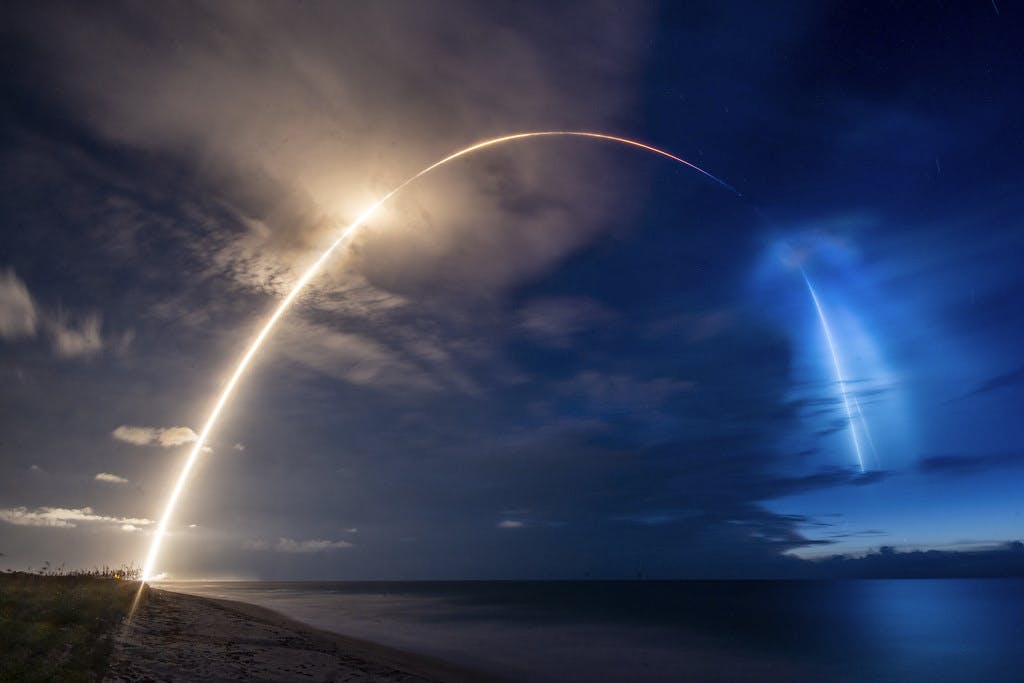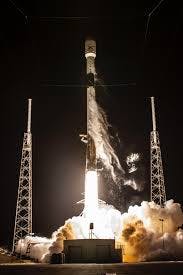The noob’s guide to Starlink: Background and practical overview of satellite internet

Blog
Elon Musk, love him or hate him, has had a large impact on multiple industries and technologies. SpaceX’s Starlink satellite internet service has the lofty (get it?) goal of creating a global broadband network with low latency, high download speeds, and the capacity to facilitate edge computing. One key goal is to provide high-speed internet to unserved/underserved, rural areas where broadband internet service (or indeed any internet service) isn’t available. It’s a tall order, since satellite internet has traditionally come with some significant caveats. But ol’ Elon has some tricks up his nicely tailored sleeve that may solve legacy space-internet problems and (eventually) help Earth-bound streamers and gamers cut the cable, if Musk’s planned swarms of satellites aren’t all shot down by pitchfork-wielding mobs of furious astronomers first.
Let’s have a look at Starlink and help you decide if modern satellite internet’s steak is as tasty as its sizzle.

How does Starlink work?
Unlike traditional satellite telecom and internet companies which utilize one or two large satellites in geosynchronous earth orbit (GEO) at approximately 22,000 miles above the surface (also called “high orbit”) to broadcast their signal to a large portion of a continent, Starlink takes a different approach, employing hundreds, even thousands of small “CubeSat” satellites orbiting the earth in low earth orbit (LEO) at only 340ish miles up. This has some inherent advantages, chiefly a huge increase in download/upload speeds and a monumental improvement in latency over previous satellite internet services.
As pointed out by the European Space Agency, “To guarantee continuity of service [using LEO], a constellation of [multiple] satellites would have to be deployed. LEO telecom systems may require 48, 66, 77, 80 or even 288 satellites to provide the required services. Several of these systems have been deployed to provide communications to mobile terminals. They use a relatively low frequency, the L- & S-bands (1.5-2.5 GHz), which is in the same range as the frequencies used by GSM mobile networks. The fact that the antennas are not very selective is a plus for them: no careful tracking of the satellite is then needed. Also, the low altitude minimises the delay due to signal travel time and reduces the power needed to establish communications.”
This information was in reference to telecom/phone users primarily, but the principle is similar when talking about broadband satellite internet. Rather than relying on one or two primary GEO satellites, SpaceX/Starlink has launched nearly 4,000 small, 573-lb (260-kg) satellites and the data and broadcast load is spread over large portions of the entire constellation, since they move around the sky relative to the earth. Each satellite is expected to last only about 5 years before orbit decay or technology limitations render them inoperative, but since they are small and (relatively) inexpensive, and launches to replace them are regular, they can be considered basically disposable. One SpaceX Falcon 9 rocket can hold and deploy up to 60 satellites in one launch.
So, what’s the primary market for Starlink at this point? As PCMag points out, “President Joe Biden has remarked on the fact that 35% of Americans in rural areas don’t have access to high-speed internet. And according to the US Census, more than a quarter-million Americans still use a dial-up connection. Even worse, 13 million people don’t have internet access at all.” A tragic state of affairs, indeed.
For now, Starlink is aimed primarily at the home/private user, though business internet services and pricing are available. Users must install (or pay someone to install) a small satellite dish in a northern-facing direction, and depending on interference from trees or roofs, an extension pole may be needed. That dish is part of the reason for the fairly steep entry cost. When you sign up for Starlink, you have to purchase the Starlink hardware (currently $599, plus a $50 handling fee, for the dish, a dish mount, a Wi-Fi router base unit, a power cable for the base unit, and a 75-foot cable for connecting the dish to the router), but there is no recurring monthly equipment expense as with a “leased” cable box or router. Your Starlink internet service then costs $110 per month (at the moment) for as long as you want the service. There is no long-term contract and you can stop and start your subscription as needed. At the end of 2022, Starlink had over 1 million active subscribers.

How many Starlink satellites are in orbit currently?
As of January 28, 2023, Starlink has launched 3,773 satellites into low earth orbit, of which 3,444 are currently operational. This information comes from astronomer Jonathan McDowell’s “Space Pages” where he tracks Starlink’s satellite constellation and others.
This may sound like a lot, and frankly it is. In fact, Musk owns roughly half of all satellites currently orbiting the planet already. But SpaceX plans to eventually have as many as 42,000 satellites as part of its “megaconstellation.”
How fast is Starlink internet, and how is it better than legacy satellite data services?
By any standards, Starlink’s performance is impressive. Utilizing LEO satellites has greatly improved latency, which was the bane of legacy satellite internet services. For example, tachus.com reports results of a study on sat-net performance: “Starlink’s median download speed in the United States was 97.23 Mbps, far exceeding our nation’s standard for broadband Internet. The study reported download speeds of 19.73 Mbps and 18.13 Mbps for HughesNet and Viasat, respectively. For upload speeds, Starlink was reported to have a median of 13.89 Mbps, while Viasat and HughesNet came in second and third with 3.38 Mbps and 2.43 Mbps, respectively. In the case of latency, an area in which satellite providers have always struggled to keep up, the difference between Starlink and the others was even bigger. Starlink reported a median latency of 45 ms. Viasat came in at a distant second place with 630 ms, while HughesNet was reported to have a latency of 724 ms. For a frame of reference, 20 ms to 40 ms is considered optimal, while 100 ms and less is considered acceptable for gaming.”
TechTarget reports, “According to a recent Speedtest by Ookla, Starlink recorded its fastest median download speed in the first quarter of 2022 at 160 Mbps in Lithuania. Starlink also clocked in at 91 Mbps in the U.S., 97 Mbps in Canada and 124 Mbps in Australia. Starlink in Mexico was the fastest satellite internet in North America, with a median download speed of 105.91 Mbps.”
So how does Starlink compare to cable or fiber internet? It’s in the same ballpark, but it’s currently not winning the game. TechTarget continues, “Currently, it looks like Starlink’s speeds still have a little way to go before competing with those of cable Internet. Ookla’s study reports the median fixed-broadband speed to be 115.22 Mbps with a latency of 15 ms (compared to Starlink’s 97.23 Mbps and 40 ms) . . . . When compared to Fiber there is absolutely no contest, and there will not be for a while. With the highest recorded Starlink download speeds topping out at just over 200 Mbps, fiber-optics deliver consistent speeds capable of symmetrical gigabit speeds. Starlink’s upload speed is still significantly slower than its download speed, making it not as ideal as symmetrical services for online gaming, videocalls, or uploading large files.”
But for those in rural areas or underserved locations where your only other option to this point was *cough* dial-up *gag*, Starlink can seem like a literal angel from heaven.

Is satellite internet the real “space race”?
SpaceX’s contributions to the Artemis mission and their high-profile Starship program are getting lots of attention, but in the background Starlink has made up the bulk of the private space company’s launches, by far. Musk may be shooting for the stars, but he obviously understands that recurring revenue is what fuels technological development in this space.
Astronomy.com reveals, “Leaked documents show that by 2025, SpaceX expects to earn five times as much revenue from Starlink as it does from all other launches combined. That potential cash is igniting a commercial space race to build the satellite-based internet that many think is the future. Companies like Amazon and OneWeb are working on their own satellite internet constellations, known as megaconstellations, too. Even China has plans for a Starlink-like project in the coming years.”
Downsides to Starlink: is it ready for prime time?
Starlink sounds like a dream to many people, particularly those in rural parts of the globe where getting ANY internet access has been spotty at best, but there are some known issues, in addition to its not-quite-as-good-as-cable performance so far. It’s getting popular enough that there appears to be some “throttling” of bandwidth if you go over a certain amount of data, as confirmed by Mashable. However, this tactic is not uncommon for “unlimited” cell phone data plans and cable internet subscriptions as well, where you may find that you do not think “unlimited” means what they think it means.
Doug Stevenson from blinqblinq.com says, “I have been a Starlink user for long enough to notice times when my connection becomes slow enough to hinder my user experience. Despite not lowering its speeds to the paltry speeds its competitors offer, this is still in direct contrast to what Starlink claims for its services.”
Upload speeds can also be impacted, and performance hasn’t sometimes met what was predicted. TechTarget revealed that “upload speeds have seen a downward curve of at least 33% in the US–from 16.29 Mbps in the first quarter of 2021 to 9.33 Mbps in the second quarter of 2022.”
While trees, rainstorms, snow, heavy fog, and other obstructions can impact Starlink performance, the primary issue at the moment is that the number of users is greater than even the considerably “mega” constellation of 3,400+ satellites can support. Stevenson continues, “Starlink, despite being the company responsible for launching and maintaining the most number of satellites orbiting the Earth, still has miles to go to support its users. The issue mainly is the sheer number of users utilizing the service, causing a significant drop in speeds on average. . . . Starlink does not have a prioritization program, so there is no scope for improvement even if you are ready to shell out some extra cash. The best way to combat this as of now is to limit your internet usage during these peak hours, which in most places is from 6 PM to 11 PM. If possible, you can schedule your high data-consuming tasks outside of these peak hours.”
Yeah, that’s not going to cut it for most users, particularly those who have grown accustomed to the firehose of bandwidth provided by cable or fiber internet.
But there are other issues with Starlink that don’t have anything to do with its latency or bandwidth throttling. Its “megaconstellation” of CubeSats is causing more than just potential crowding in low Earth orbit: Starlink’s satellites are visible from Earth with the naked eye. As Space.com points out, “This show is not welcomed by all and can significantly hinder both optical and radio astronomical observations. You don’t need any special equipment to see Starlink satellites . . . . [they] can appear as a string of pearls or a ‘train’ of bright lights moving across the night sky.”
Astronomy.com reports, “For months, astronomers have been voicing concerns about how light pollution from the planned satellite mega-constellation would hinder their ability to do research.”
The American Astronomical Society’s Committee on Light Pollution, Radio Interference, and Space Debris is trying to understand “to what extent is this a nuisance, and to what extent is this an existential threat.”
Well, that escalated quickly. Whether or not Elon Musk’s flock of shiny, potentially annoying satellites can be considered an existential threat is up for debate, but we may soon find that the glowing trains of satellites crossing the starscape of the night sky is as common as the contrails of jet airliners crossing the sky during the day. It’s a good thing everyone will be too busy watching all of their 4K streaming TV shows and won’t notice the sky at all.
–By Jeff Davis, Intergalactic Scribe
Sources:
https://www.space.com/spacex-starlink-satellites.html
https://www.techtarget.com/whatis/definition/Starlink
https://www.esa.int/Applications/Telecommunications_Integrated_Applications/Orbits
https://www.tachus.com/post/starlink-vs-fiber
https://astronomy.com/news/2021/06/how-do-starlink-satellites-actually-work
https://www.pcmag.com/how-to/starlink-starter-kit-how-to-get-it-and-set-it-up